|
Hibiscus, Introductions by the Late Dr. Sam McFadden
Written by Jerry Parsons in July, 2002; revised August, 2005;
additional information provided by Dr. Sam McFadden, April, 2007
Three new herbaceous perennial Hibiscus selections were released in 1962 by the Horticulture Department of the University of Florida at Gainesville. These were hybrids of Hibiscus species that are native in Florida and of existing named cultivars that were obtained from nursery sources * these being listed under names such as "Large-flowered Garden Mallows"; "Mallow Marvels", some being as old as 150 years; or as "Hardy Hibiscus". The breeder of these released selections was Assistant Horticulturist, Dr. Sam E. McFadden, who assigned their cultivar names: 'Plume', 'Plush', and 'Flare' based on their unique flower traits. Distribution of these showed that the first two named were short-lived, and only 'Flare' was really suitable in trade handling for garden use.
'Flare' was obtained by hybridizing (H. moscheutos) seedlings with a named perennial Hibiscus cultivar 'Brilliant Cerise' obtained from a California nursery source. Stock plants of 'Flare' have been maintained in Tennessee by Dr. McFadden and propagation material has been supplied to Dr. Jerry Parsons at Texas A&M University in San Antonio, Texas, along with stem cuttings of two additional perennial Hibiscus selections from this same project that had been named 'Swanee' and 'Red River' but not formally recorded. Both of these have since proven to be suitable, long-lived, but 'Swanee' is difficult to propagate from stem cuttings.
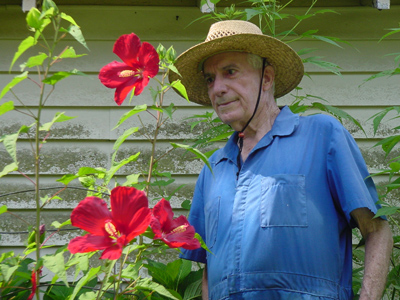
McFadden with Red River Hibiscus on July 23, 2008
'Swanne' was obtained from a cross of H. grandiflorus and a seedling resembling 'Flare'. The parentage of 'Red River' included contributions from H. coccineus from the wild in Florida and the first two cultivars: 'Old Glory' obtained from the Riegle Brothers Nursery in Georgia, and 'Annie J. Henning' from an Ohio nursery source; the latter supplied the white basal petal spot that re-appears in the 'Red River' flower.
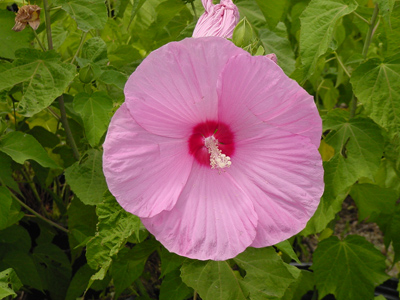
Swanee
|
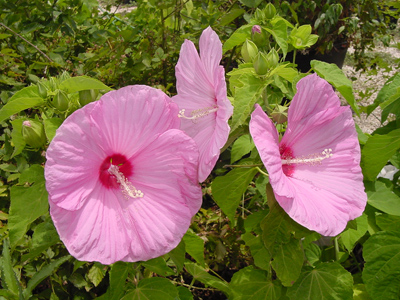
Swanee
|
RED RIVER ROSE MALLOW
(Hibiscus x 'Red River)
A selection bred by Dr. Sam McFadden of Somerville, Tennessee, with showy deep red flowers. The large cup shaped, wine-red flowers are accented by a white star in the throat and glowing yellow pollen. The foliage is an attractive maple-like with an apple green color. He crossed several H. mouchetus cultivars with H. coccinus (for red color) via H. miltaris (leaf form) to allow crossing. The H. mouchetus mallow seedlings were crossed with the commercial varieties 'Annie Jay Henning' (out of Ohio) and 'Old Glory' (Reigel Brothers Nursery out of Georgia). Zone 5-10
|
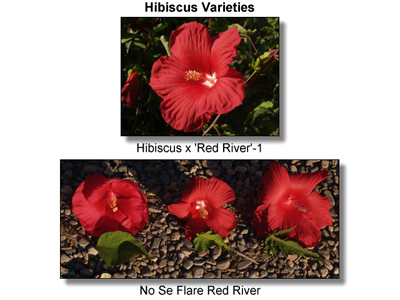
Red River
|
FLARE ROSE MALLOW
(Hibiscus moscheutos 'Flare')
'Flare' is a selection, developed by Dr. Sam McFadden of Somerville, Tennessee. This showy perennial has large glowing (the name 'Flare' was used by the breeder to closely depict the color of this flower, i.e., the color of a burning flare), fuchsia flowers. The maple-like emerald green foliage is very attractive on a compact plant. He crossed H. mouchetus ('Brilliant Cerise' and 'Clown (a California source) x H. mouchetus seedlings. He said that Flare is a carbon-copy of 'Brilliant Cerise' but the Flare seedling was chosen for compactness of growth and dark green color -- Dr. McFadden made a pretty good call! Zone 5-10.
|
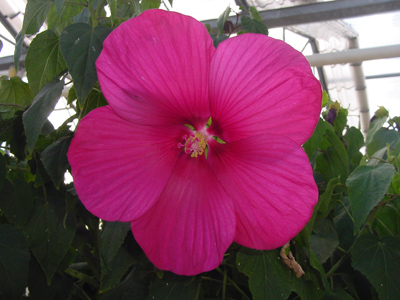
Flare Hibiscus
|
THE LITTLE KNOWN HISTORY OF ‘FLARE’ HIBISCUS
In the mid-1990s, Dr. Sam McFadden of Somerville, Tenn., a well-known plant breeder, developed a hibiscus whose color he didn’t like, one whose gaudiness actually embarrassed him a bit.
The best he could do was say it was the same color seen when a road flare is struck at night: a brilliant, hot florescent fuchsia.
But what might have been too gaudy for Tennessee would play well in Texas, especially in the southwest part of the state where blindingly bright sun washes out more subtle colors.
In 1998, Flare along with Moy Grande, a red hibiscus variety with 12-inch diameter blooms, and Lord Baltimore, another red variety, were named Texas Superstars. All three became VERY popular.
But since 1998, two new colors, a seedling of ‘Flare’ named ‘Pink Flare’ and a sport of ‘Flare’ named ‘Peppermint Flare’, were found and named Texas Superstars for 2010.
The ‘Flare’ variety was nearly abandoned by Dr. McFadden to obscurity in Tennessee because it was too scarlet and too gaudy until Dr. Parsons reminded him that “folks in Texas paint their houses that color!”
The plants are also practically sterile, not producing seed, which encourages a “luxuriant” re-blooming. By practically sterile, it’s meant they produce seeds but only rarely. Any seed produced usually results in a useful offspring.
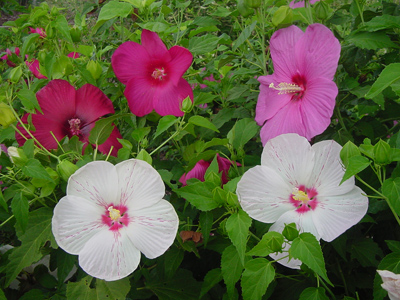
Flare seedlings
|
|
|
|



